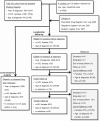Psychotropic Drugs in Patients with Cushing's Disease Before Diagnosis and at Long-Term Follow-Up: A Nationwide Study
- PMID: 33567076
- PMCID: PMC8118365
- DOI: 10.1210/clinem/dgab079
Psychotropic Drugs in Patients with Cushing's Disease Before Diagnosis and at Long-Term Follow-Up: A Nationwide Study
Abstract
Context: Psychiatric symptoms are common in Cushing's disease (CD) and seem only partly reversible following treatment.
Objective: To investigate drug dispenses associated to psychiatric morbidity in CD patients before treatment and during long-term follow-up.
Design: Nationwide longitudinal register-based study.
Setting: University Hospitals in Sweden.
Subjects: CD patients diagnosed between 1990 and 2018 (N = 372) were identified in the Swedish Pituitary Register. Longitudinal data was collected from 5 years before, at diagnosis, and during follow-up. Four matched controls per patient were included. Cross-sectional subgroup analysis of 76 patients in sustained remission was also performed.
Main outcome measures: Data from the Swedish Prescribed Drug Register and the Patient Register.
Results: In the 5-year period before and at diagnosis, use of antidepressants (odds ratio [OR] 2.2 [95% confidence interval (CI) 1.3-3.7]) and 2.3 [1.6-3.5]), anxiolytics [2.9 (1.6-5.3) and 3.9 (2.3-6.6)], and sleeping pills [2.1 (1.2-3.7) and 3.8 (2.4-5.9)] was more common in CD than controls. ORs remained elevated at 5-year follow-up for antidepressants [2.4 (1.5-3.9)] and sleeping pills [3.1 (1.9-5.3)]. Proportions of CD patients using antidepressants (26%) and sleeping pills (22%) were unchanged at diagnosis and 5-year follow-up, whereas drugs for hypertension and diabetes decreased. Patients in sustained remission for median 9.3 years (interquartile range 8.1-10.4) had higher use of antidepressants [OR 2.0 (1.1-3.8)] and sleeping pills [2.4 (1.3-4.7)], but not of drugs for hypertension.
Conclusions: Increased use of psychotropic drugs in CD was observed before diagnosis and remained elevated regardless of remission status, suggesting persisting negative effects on mental health. The study highlights the importance of early diagnosis of CD, and the need for long-term monitoring of mental health.
Keywords: Cushing’s syndrome; depression; hypercortisolism; neuropsychiatry; sleeping disorder.
© The Author(s) 2021. Published by Oxford University Press on behalf of the Endocrine Society.
Figures



Comment in
-
Cushing "Blues".J Clin Endocrinol Metab. 2021 Jun 16;106(7):e2816-e2818. doi: 10.1210/clinem/dgab239. J Clin Endocrinol Metab. 2021. PMID: 33838046 No abstract available.
References
-
- Lacroix A, Feelders RA, Stratakis CA, Nieman LK. Cushing’s syndrome. Lancet. 2015;386(9996):913-927. - PubMed
-
- Pivonello R, Isidori AM, De Martino MC, Newell-Price J, Biller BM, Colao A. Complications of Cushing’s syndrome: state of the art. Lancet Diabetes Endocrinol. 2016;4(7):611-629. - PubMed
-
- Ragnarsson O, Olsson DS, Papakokkinou E, et al. . Overall and disease-specific mortality in patients with Cushing disease: A Swedish Nationwide Study. J Clin Endocrinol Metab. 2019;104(6):2375-2384. - PubMed
-
- Cushing H. The basophil adenomas of the pituitary body and their clinical manifestations (pituitary basophilism). Bull Johns Hopkins Hosp. 1932;50:137-195.
Publication types
MeSH terms
Substances
LinkOut - more resources
Full Text Sources
Other Literature Sources
Medical

